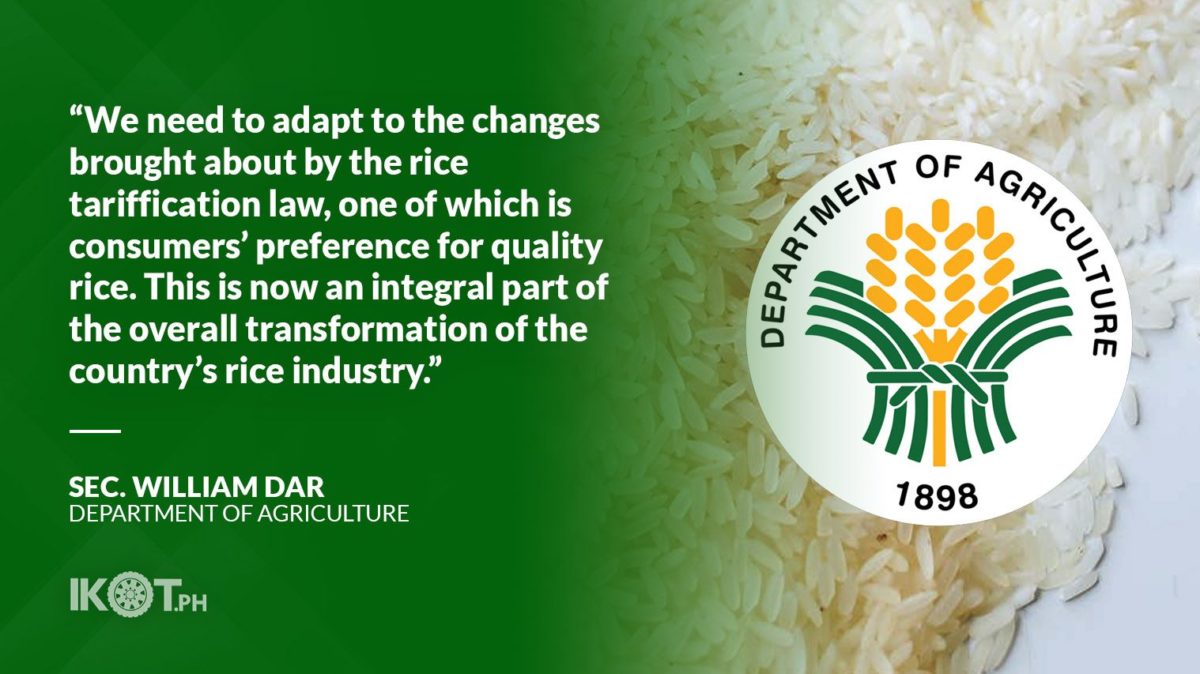After attaining increased palay production during the 2019-2020 dry season and the current main season, the Department of Agriculture (DA) now eyes the promotion of rice varieties that are preferred by consumers.
“We need to adapt to the changes brought about by the rice tariffication law, one of which is consumers’ preference for quality rice. This is now an integral part of the overall transformation of the country’s rice industry,” said Agriculture Secretary William Dar.
“That is why for the succeeding cropping seasons, we are not just after attaining production targets, but also producing quality rice for Filipino consumers that will provide higher income for farmers,” Dar added.
The agriculture chief made the pitch during a virtual meeting with leaders of farmers’ groups, millers and traders, from major rice-producing provinces.
For their part, rice millers and traders said they were having difficulty buying palay because of low quality, composed mostly of assorted or ‘rumble’ varieties that when milled produce chalky and broken grains.
“The COVID-19 pandemic has made it hard for us to sell our rice stocks because of lack in demand, which was made even harder by the low quality of palay harvest this season,” a Bulacan rice miller said.
“If farmers want to command good prices, they should plant better quality rice seeds and what the consumers want,” a miller from Nueva Ecija said.
“Consumers now prefer rice varieties that are long-grain, and taste and smell better when cooked.”
A trader from Isabela, on the other hand, said that consumers now prefer rice varieties that are long-grain, and taste and smell better when cooked. Simply, they should possess the so-called “4M for maganda, mura, mabango at malambot.”
An informal survey done by the rice industry groups showed that 40 percent of consumers prefer rice with said attributes.
Millers and traders are thus one in saying that farmers should now plant varieties that have good milling and eating qualities, and preferred by consumers.
They offered to help the DA, through the Philippine Rice Research Institute (PhilRice), promote recommended rice varieties that farmers should plant in succeeding seasons.
In reply, the agriculture head said they will also meet with seed producers to discuss the preferred rice varieties of consumers, and the desired levels of productivity that will provide farmers more income.
“We have to make seed producers, farmers and other stakeholders understand that our overall strategy now is inclusive market-oriented development,” he said.
“We need to adapt to changes brought about by the new regime.”
“Kung ano demand ng market, kung ano ang pangangailangan ng consuming public iyon ang dapat i-produce ng ating mga magsasaka. We need to adapt to changes brought about by the new regime,” Dar added.
He said the DA will hold consultations with farmers, seed producers, traders, millers, and other stakeholders to determine current industry trends, demand of the domestic retail market and institutional buyers, customers’ needs and wants, and needed policy shifts or reforms and government interventions.
Palay harvest during the first semester of 2020 totaled 8.387 million metric tons (MMT), 1.4% more than the 8.269 MMT for the same six-month period last year. Second semester palay output this year is forecast at 11.954 MMT, 13.4% more than last year’s 10.545 MMT.

